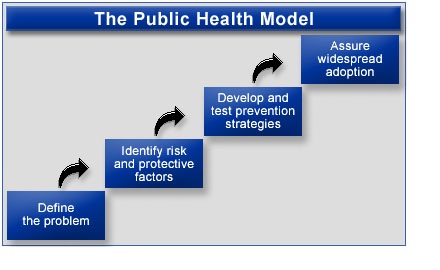PREVENTING VIOLENCE WITH A PUBLIC HEALTH APPROACH: SUCCESSES IN MINNEAPOLIS, BALTIMORE, AND NEW ORLEANS
by Ali Goodyear |
 Violence is preventable, and prevention is a hallmark of the public health approach. Youth violence is more likely to occur when complex environmental factors coincide, such as poverty, structural racism, and easy access to alcohol, drugs, and weapons. It festers in environments lacking protective elements like community connections, engaged mentors, and prosocial out-of-school activities.
Violence is preventable, and prevention is a hallmark of the public health approach. Youth violence is more likely to occur when complex environmental factors coincide, such as poverty, structural racism, and easy access to alcohol, drugs, and weapons. It festers in environments lacking protective elements like community connections, engaged mentors, and prosocial out-of-school activities.
Addressing these factors is not the mandate of one group or one field, which is why the public health approach focuses on engaging multiple sectors to work together and with community members to improve the environment for young people. This complements criminal justice approaches and brings an important perspective to the work of addressing violence. Key characteristics include using community-level data to drive practice, reducing the impact of risk factors, increasing resilience factors, and concentrating on effective policies and practices to prevent violence before it occurs, thus reducing its far-reaching impacts, and ensuring communities' health and safety.
Given that the causes of violence are intricate and interrelated, a successful prevention strategy must involve community and multisector collaboration to strengthen the factors that protect and support communities, families, and young people and reduce factors that threaten their well-being. Increasingly, cities throughout the United States are adopting a public health approach to enhance community safety. Minneapolis, Minn.; Baltimore, Md.; and New Orleans, La.; are just a few examples of National Forum cities that have seen marked reductions in violence by implementing a public health approach. Although each city’s approach is different, they all incorporate a collaborative framework and a commitment to preventing violence by addressing its underlying contributors—for example, poverty, substance abuse, neighborhood deterioration, and school climate.
Recognizing violence was the leading cause of death among young people in Minneapolis, many sectors came together to create the Blueprint for Action. The Blueprint acknowledges violence is inextricably linked to poverty and racial, ethnic, and socioeconomic disparities, and it delineates five youth-centered goals for violence prevention and intervention. Through implementation of the Blueprint, Minneapolis has launched numerous violence prevention initiatives, including North4, a collaboration to engage and employ gang-affiliated youth; the Juvenile Supervision Center at City Hall, which stays open 24/7 to engage youth who violate curfew, cut school, or get picked up for minor offenses in Hennepin County; and school-based clinics in Minneapolis Public Schools, which provide parenting support and mental health resources to families and students. Centered on norms change and collaboration, the Blueprint for Action has made significant strides toward ending youth violence in Minneapolis.
In Baltimore, where youth violence is also a major public health challenge, the city health department initiated the Safe Streets program. The program, launched in 2007, acts in concert with traditional public health principles—changing social norms, reducing risk, and providing alternatives for violent behavior—and works in communities where people are at highest risk of being victims or perpetrators of violence. The framework identifies brewing conflicts, retaliatory events, and those who are most at risk, and seeks to intervene and reduce that risk. Ultimately, the initiative aims to change how people think about violence, so it is no longer seen as a way to resolve conflicts.
The New Orleans NOLA for Life violence reduction plan is another example of a multisector group working to rebuild neighborhoods, promote jobs, and engage communities in violence prevention. Established in 2012, NOLA for Life comprises 35 multisector prevention initiatives, including NOLA for Life Days, in which citizens team up to clean vacated lots and other areas with high rates of violence; the development of a Community of Practice, which established a continuum of services to improve outcomes for boys and men of color; and NOLA Youth Works, which offers quality summer experiences that build a career pipeline for local youth.
Recently, Prevention Institute collaborated with representatives from 13 of the country's largest cities to map out exactly what it takes to prevent violence, and provided examples of what has worked so far using a public health approach. The Urban Agenda calls attention to the need for city- and neighborhood-level violence prevention strategies that are designed to make the greatest impact. These strategies must be grounded in research and informed by communities.
|
|
|
